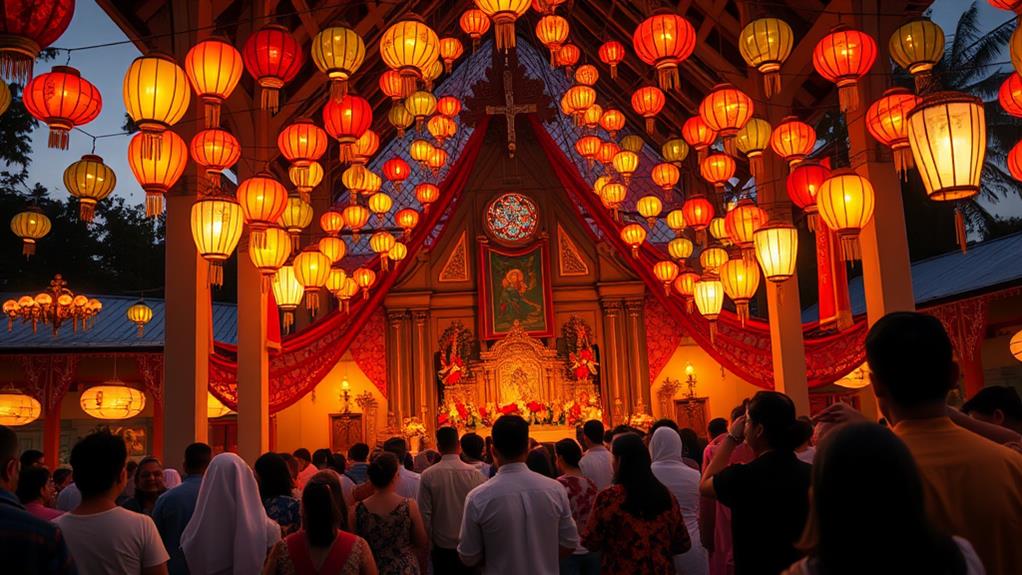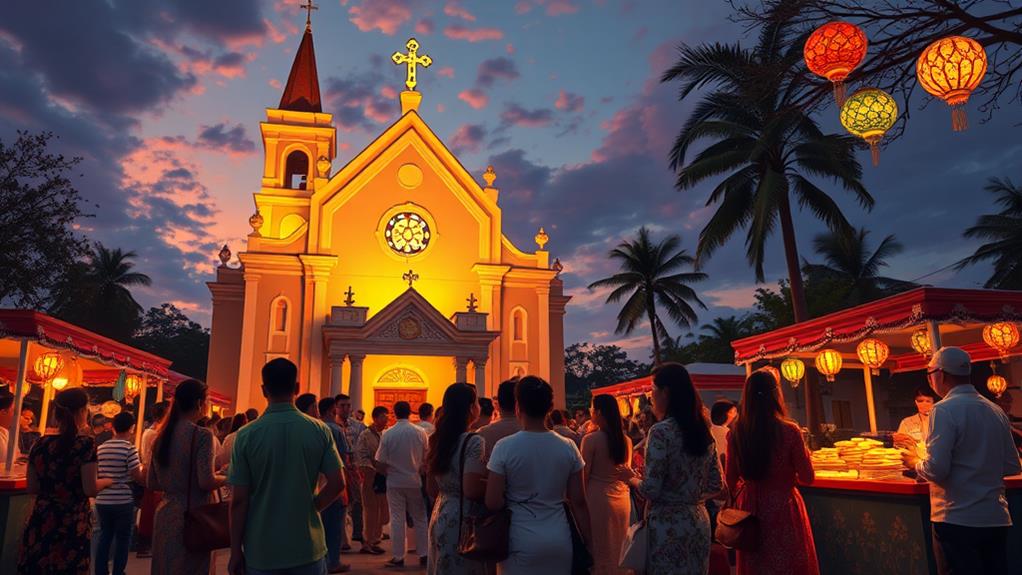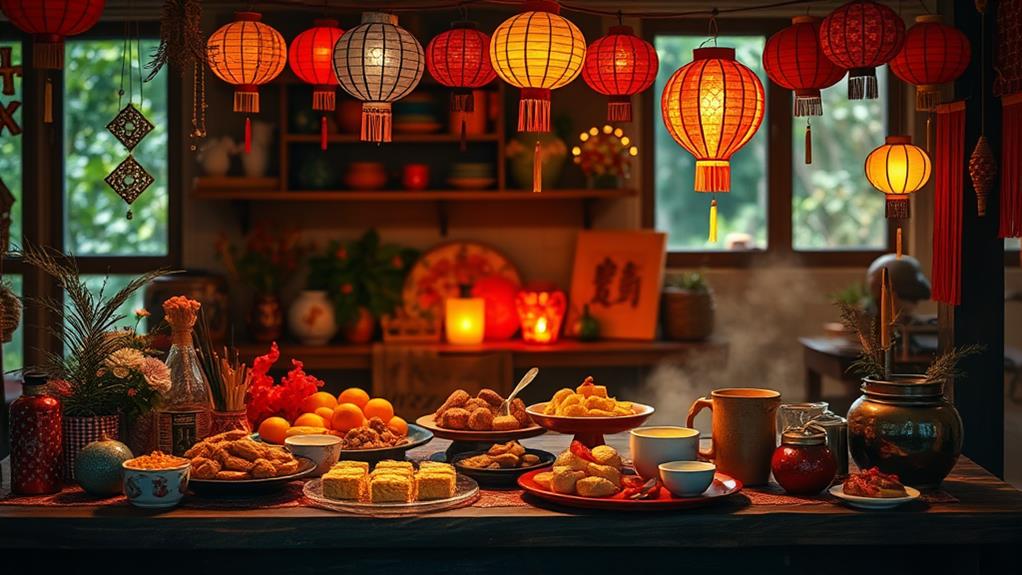Simbang Gabi: A Filipino Christmas Tradition
Simbang Gabi is a vibrant Filipino Christmas tradition that features nine dawn Masses, which connect people to their cultural roots and community spirit.
Originating in 1669, this practice evolved from Misa de Gallo, initially designed for farmers who needed to attend Mass before working in the fields.
Fostering Family Bonds and Community Spirit
Simbang Gabi fosters deep family bonds through shared experiences, such as enjoying traditional Filipino delicacies like bibingka and puto bumbong after every Mass.
This tradition also promotes community spirit, as people come together to celebrate the holiday season.
Participating in Simbang Gabi
In modern times, people can participate in Simbang Gabi in person or online, blending tradition with contemporary elements.
This flexibility allows more people to connect with their cultural heritage and community.
Symbolism and Impact
Each Simbang Gabi Mass represents hope and unity, especially poignant amidst today's challenges.
By participating in this tradition, people can experience a sense of connection and belonging to their community.
History of Simbang Gabi

Simbang Gabi: A Cherished Filipino Christmas Tradition
Origin and Purpose
Simbang Gabi, a beloved Filipino Christmas tradition, has its roots in 1669 during the Spanish colonization of the Philippines.
It was originally called Misa de Gallo, or Mass of the Rooster, and was created to accommodate farmers who needed to attend early morning Masses before sunrise.
Challenges and Evolution
Between 1680 and 1689, a decree from the Holy See halted native hymns, temporarily stifling the celebration.
However, after Archbishop Felipe Pardo's death, Simbang Gabi regained momentum, evolving into a cornerstone of Filipino traditions by the 19th century.
The Nine-Day Celebration
The nine-day Simbang Gabi, culminating in the anticipation of Christmas, became a novena of Masses honoring the Blessed Virgin.
This devotion reflects the deep spiritual significance of the season, intertwining faith with cultural identity.
A Historic Milestone
Pope Francis marked a historic chapter in the tradition's narrative by leading a Simbang Gabi Mass on December 15, 2019, the first papal celebration of this deeply-rooted event,
further solidifying its importance in the collective consciousness of Filipinos around the world.
Cultural Significance
Simbang Gabi: A Cherished Filipino Tradition
Simbang Gabi, a series of nine dawn Masses, is a vital part of Filipino culture, especially during Christmas. It goes beyond religious observance, fostering a strong sense of cultural identity and community bonding.
Generational Connection
Simbang Gabi strengthens family ties as families gather together, passing down traditions to younger generations. This shared experience reinforces common values and creates lasting memories.
Spiritual Preparation
The nine Masses serve as a period of spiritual reflection, allowing individuals to prepare themselves for the Christmas celebration. Through prayer and devotion, participants reflect on their values and priorities.
Culinary Heritage
After each Mass, traditional Filipino delicacies like bibingka and puto bumbong are savored, enhancing communal bonds and celebrating cultural heritage.
Acts of Devotion
Attending all nine Masses is considered a powerful panata, believed to bring blessings and answers to personal prayers. This act of devotion demonstrates commitment and faith.
Modern Practices

Traditional Simbang Gabi Evolves with Modern Practices
Simbang Gabi, a cherished Filipino Christmas tradition, has adapted to modern times while retaining its spiritual essence.
In recent years, the integration of technology has transformed how people participate. Traditionally, Simbang Gabi involved a series of early morning Masses at 4 AM, primarily catering to farmers.
However, with the rise of live broadcasting on radio and TV, virtual participation has become commonplace, ensuring everyone can join in, especially during the pandemic.
Hybrid Mass options now offer flexibility. You can choose between attending in person or engaging online, fostering a sense of inclusivity.
This adaptation not only retains the spiritual essence of the Masses but also enhances the experience through contemporary music and choir performances that blend with traditional Filipino hymns.
Food offerings have also evolved. Traditional delicacies like bibingka and puto bumbong are now merged with modern culinary options, catering to diverse tastes.
By partaking in these Masses, you're not just honoring the past but actively shaping the future of Simbang Gabi, creating a rich tapestry that resonates with both history and modernity in this Filipino Christmas tradition.
Community and Family Celebrations
During the Simbang Gabi season, families come together to celebrate the nine Masses that form the heart of this tradition. This communal experience fosters community bonding, reinforcing shared values and cultural heritage.
Family Ties and Lasting Memories are strengthened through shared experiences. Attending Masses together creates opportunities for families to bond and create lasting memories.
Traditional Local Delicacies are an integral part of Simbang Gabi celebrations. After Mass, families savor beloved treats like bibingka and puto bumbong, which enhance the spirit of celebration.
Agape Meals are hosted by many churches, inviting everyone to share food and fellowship. This promotes warmth and hospitality, bringing the community closer together.
Cultural Preservation is encouraged through the tradition of Simbang Gabi. The passing down of parol gifts and stories ensures that the rich tapestry of Filipino culture continues through generations.
These elements intertwine to create a vibrant atmosphere where family celebrations flourish, reinforcing not only individual bonds but also a deep connection to the community at large.
How is the Simbang Gabi tradition similar to Fiesta celebrations in terms of community and religious significance?
Simbang Gabi tradition and fiesta celebrations honoring patron saints both bring communities together in celebration. They each hold religious significance, as Simbang Gabi is a novena leading up to Christmas and fiestas honor the patron saint of a particular town. Both traditions foster a sense of community and spiritual devotion.
Traditional Cuisine

Simbang Gabi's traditional cuisine is a reflection of Filipino culture and heritage. It's characterized by a vibrant array of flavors and aromas that fill the air during the early morning Masses.
Bibingka and puto bumbong are two traditional rice cakes that are often enjoyed after the services. These treats symbolize the rich culinary heritage of the Philippines and are an integral part of the Simbang Gabi celebration.
Bibingka is a rice cake baked with coconut milk, giving it a distinct flavor and aroma.
Puto bumbong, on the other hand, is made from purple rice and is known for its bright colors. These delicacies are typically paired with hot chocolate or salabat, which creates a warm and comforting experience that nourishes both body and spirit.
Historically, food offerings at Simbang Gabi catered to the farmers who attended the Masses before their workday. This highlights the deep connection between sustenance and community.
Local vendors set up stalls outside churches, selling various traditional foods that enhance the communal atmosphere. This culinary aspect of Simbang Gabi fosters social interaction and community bonding, allowing people to share in the joy of this Filipino tradition while indulging in the flavors that bring people together.
Themes of Hope in 2023
Simbang Gabi, a cherished Filipino tradition, begins on December 16 and serves as a beacon of hope and resilience amidst ongoing societal challenges. Collective Healing is a key theme, as coming together promotes emotional recovery and strengthens bonds. This is evident in the vibrant Christmas lights and parol decorations that symbolize light in the darkness.
As participants gather for pre-dawn Masses, they reflect on Perseverance and Faith. By counting personal blessings, individuals reinforce optimism for the future. For instance, acknowledging the support of loved ones or personal achievements fosters a sense of gratitude and hope.
Unity in Prayer is another essential theme, as shared experiences during these gatherings cultivate a sense of belonging. This is particularly important during challenging times, as it reminds individuals that they aren't alone. The collective prayers and songs create a sense of community and togetherness.
Furthermore, Simbang Gabi emphasizes Support for the Vulnerable, acknowledging those facing unemployment and poverty. This encourages community action and support for those in need. By recognizing these challenges, individuals can work together to create positive change.
In 2023, Simbang Gabi not only honors tradition but also reinforces the spirit of a brighter future. By participating in this celebration, individuals contribute to a larger narrative of hope, reminding everyone of the power found in togetherness and faith.
Questions and Answers
What Is the Tradition of Simbang Gabi for Christmas?
In the Philippines, Simbang Gabi is a cherished Christmas tradition that combines faith and festive celebrations.
This nine-day series of dawn masses, which begins on December 16, is a significant part of Filipino culture.
It emphasizes the religious significance of the season, allowing families and friends to come together and strengthen their bonds.
During Simbang Gabi, homes are adorned with vibrant decorations, setting a festive mood.
The tradition also involves indulging in local delicacies, such as bibingka and puto bumbong, which add to the celebratory atmosphere.
Local variations of the tradition may introduce unique practices, but the core spirit of community and faith remains the same.
Why Is Simbang Gabi Held at Dawn?
Simbang Gabi's early dawn gatherings originated as a way to accommodate farmers. In the past, farmers would wake up early to tend to their fields, so the dawn Masses allowed them to attend church before starting their daily work.
This blending of community involvement with spiritual preparation helped farmers prepare for the birth of Jesus Christ during the Advent season.
As you participate in Simbang Gabi, you'll notice festive gatherings that reinforce family traditions. Each area has its own unique local variations, showcasing the diversity of the celebration.
These contemporary practices often carry symbolic meanings, allowing you to connect deeply with your faith and the communal anticipation of celebration during the Advent season.
What Is Simbang Gabi Mass?
Simbang Gabi Mass is a nine-day series of evening Masses that begins on December 16 and ends on Christmas Eve.
This celebration has a rich history and cultural significance in the Philippines. Locals gather together, sharing traditional foods and music, which creates a strong sense of community involvement.
The Masses serve as a spiritual preparation for Christmas, allowing individuals to reflect on their personal connections to the season.
Each region in the Philippines has its unique variations of Simbang Gabi Mass, showcasing local traditions and customs.
Modern adaptations have made the celebration more inclusive, allowing people of all backgrounds to participate.
Participating in all nine Masses is a significant commitment, but it deepens one's appreciation for this cherished tradition and fosters a sense of belonging and anticipation for Christmas.
What Happens at Simbang Gabi?
Simbang Gabi is a celebration of Filipino culture and faith.
At Simbang Gabi, the nine dawn Masses leading up to Christmas combine history and spiritual significance.
Each Mass features a festive atmosphere filled with traditional music that resonates deeply with the community.
Community bonding is a key aspect of Simbang Gabi. You'll gather with your community to share in the experience, fostering family bonding and connection.
Traditional Filipino cuisine, such as bibingka, is often shared during these gatherings.
Simbang Gabi is more than just a ritual; it's a celebration of faith and tradition. As you reflect on the experience, you'll come to appreciate the warmth and connection that comes from sharing in these traditions with others.